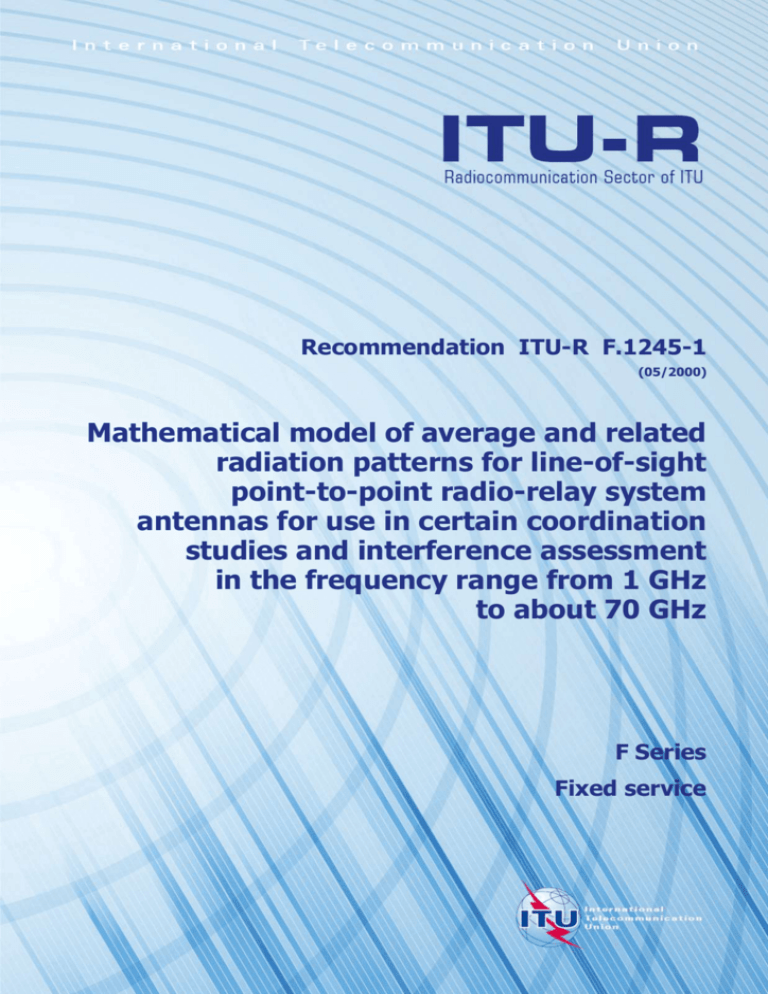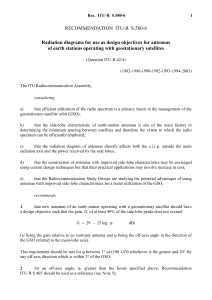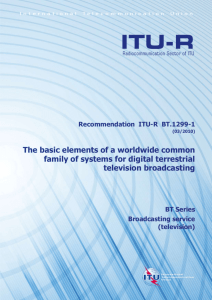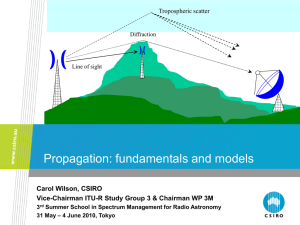
Recommendation ITU-R F.1245-1
(05/2000)
Mathematical model of average and related
radiation patterns for line-of-sight
point-to-point radio-relay system
antennas for use in certain coordination
studies and interference assessment
in the frequency range from 1 GHz
to about 70 GHz
F Series
Fixed service
ii
Rec. ITU-R F.1245-1
Foreword
The role of the Radiocommunication Sector is to ensure the rational, equitable, efficient and economical use of the
radio-frequency spectrum by all radiocommunication services, including satellite services, and carry out studies without
limit of frequency range on the basis of which Recommendations are adopted.
The regulatory and policy functions of the Radiocommunication Sector are performed by World and Regional
Radiocommunication Conferences and Radiocommunication Assemblies supported by Study Groups.
Policy on Intellectual Property Right (IPR)
ITU-R policy on IPR is described in the Common Patent Policy for ITU-T/ITU-R/ISO/IEC referenced in Annex 1 of
Resolution ITU-R 1. Forms to be used for the submission of patent statements and licensing declarations by patent
holders are available from http://www.itu.int/ITU-R/go/patents/en where the Guidelines for Implementation of the
Common Patent Policy for ITU-T/ITU-R/ISO/IEC and the ITU-R patent information database can also be found.
Series of ITU-R Recommendations
(Also available online at http://www.itu.int/publ/R-REC/en)
Series
BO
BR
BS
BT
F
M
P
RA
RS
S
SA
SF
SM
SNG
TF
V
Title
Satellite delivery
Recording for production, archival and play-out; film for television
Broadcasting service (sound)
Broadcasting service (television)
Fixed service
Mobile, radiodetermination, amateur and related satellite services
Radiowave propagation
Radio astronomy
Remote sensing systems
Fixed-satellite service
Space applications and meteorology
Frequency sharing and coordination between fixed-satellite and fixed service systems
Spectrum management
Satellite news gathering
Time signals and frequency standards emissions
Vocabulary and related subjects
Note: This ITU-R Recommendation was approved in English under the procedure detailed in Resolution ITU-R 1.
Electronic Publication
Geneva, 2010
ITU 2010
All rights reserved. No part of this publication may be reproduced, by any means whatsoever, without written permission of ITU.
Rec. ITU-R F.1245-1
1
RECOMMENDATION ITU-R F.1245-1*
MATHEMATICAL MODEL OF AVERAGE AND RELATED RADIATION PATTERNS FOR
LINE-OF-SIGHT POINT-TO-POINT RADIO-RELAY SYSTEM ANTENNAS FOR USE
IN CERTAIN COORDINATION STUDIES AND INTERFERENCE ASSESSMENT
IN THE FREQUENCY RANGE FROM 1 GHz TO ABOUT 70 GHz
(Question ITU-R 110/9)
(1997-2000)
Rec. ITU-R F.1245-1
The ITU Radiocommunication Assembly,
considering
a)
that the reference radiation pattern of line-of-sight point-to-point radio-relay system antennas stated in
Recommendation ITU-R F.699 gives the peak envelope of side-lobe patterns;
b)
that if the peak envelope radiation pattern is used in the assessment of the aggregate interference consisting of
many interference entries, the predicted interference will result in values that are greater than values that would be
experienced in practice;
c)
that, therefore, it is necessary to use the antenna radiation pattern representing average side-lobe levels in the
following cases:
–
to predict the aggregate interference to a geostationary or non-geostationary satellite from numerous radio-relay
stations;
–
to predict the aggregate interference to a radio-relay station from many geostationary satellites;
–
to predict interference to a radio-relay station from one or more non-geostationary satellites under the continuously
variable angle which should be averaged;
–
in any other cases where the use of the radiation pattern representing average side-lobe levels is appropriate;
d)
that a simple mathematical formula is preferable to the radiation pattern representing average side-lobe levels;
e)
that a mathematical model is also required for generalized radiation patterns of antennas for statistical
interference analyses involving a few interference entries such as from geostationary satellites into systems in the fixed
service,
recommends
1
that, in the absence of particular information concerning the radiation pattern of the line-of-sight radio-relay
system antenna involved, the mathematical model of the average radiation pattern as stated below should be used for the
applications referred to in considering c);
2
that the following mathematical model of the average radiation pattern should be adopted for frequencies in the
range 1-40 GHz and provisionally in the range 40 GHz to about 70 GHz;
2.1
in cases where the ratio between the antenna diameter and the wavelength is greater than 100 (D / > 100), the
following equation should be used (see Note 1):
G() Gmax – 2.5
D
2
for
0 m
G() G1
for
m max (m, r)
G() 29 – 25 log
for
G() –13
for
10–3
max (m, r) 48
48 180
_______________
*
This Recommendation should be brought to the attention of Radiocommunication Study Groups 4 (WP 4A), 6 (WP 6S)
7 (WP 7B), 8 (WP 8D) and Working Party 4-9S.
2
Rec. ITU-R F.1245-1
where:
Gmax:
maximum antenna gain (dBi) (see Note 2)
G():
gain (dBi) relative to an isotropic antenna
:
off-axis angle (degrees)
D:
:
antenna diameter
expressed in the same unit
wavelength
G1 :
gain of the first side lobe
2 15 log (D/)
20
Gmax G1
D
m
degrees
r 12.02 ( D / )0 .6
degrees
2.2
in cases where the ratio between the antenna diameter and the wavelength is less than or equal to
100 (D/ 100), the following equation should be used (see Notes 3 and 7):
D
G() Gmax – 2.5 10–3
2
for 0
m
G() 39 – 5 log (D/) – 25 log
for m
G() –3 – 5 log (D/)
for 48 180
3
that Annex 1 may be provisionally referred to for generalized radiation patterns of point-to-point radio-relay
system antennas which may be used only in statistical interference analyses involving a few interference entries such as
from geostationary satellites into systems in the fixed service (see Note 9);
4
that the following Notes should be regarded as part of this Recommendation.
NOTE 1 – The average side-lobe levels in § 2.1 are 3 dB lower than peak envelope side-lobe levels in § 2.1 of
Recommendation ITU-R F.699.
NOTE 2 – The relationship between Gmax and D/ is given in Recommendation ITU-R F.699.
NOTE 3 – The mathematical model in § 2.2 was derived from the condition that the total power emitted from the antenna
should not exceed the total power fed into the antenna.
NOTE 4 – The radiation pattern in § 2 is only applicable for one polarization (horizontal or vertical).
NOTE 5 – The radiation pattern included in this Recommendation is only for antennas which are rotationally
symmetrical.
NOTE 6 – The average radiation pattern in this Recommendation may be somewhat different from radiation patterns of
actual antennas. The purpose of this Recommendation is solely to provide a mathematical model for use in interference
assessment for the applications referred to in considering c).
NOTE 7 – Radio-relay antennas generally employ linear polarization. Therefore, when the interference from a system
employing circular polarization, such as in the mainbeam-to-mainbeam coupling from space stations, is evaluated, the
effective radio-relay antenna gain, Geff (), taking account of polarization advantage, may be estimated by using the
following formula in the main-lobe region (0 m) instead of the first formula in § 2.2:
Geff () 10 log 10 0.1G () 0.02 10 0.1Gmax 3
dBi
where G() is the gain according to the first formula in § 2.2.
The above formula assumes that the cross-polarized antenna gain for 0 m is 17 dB lower than Gmax. The
polarization advantage should not be expected for m or when the radio-relay station is outside the main beam of the
antenna of the other service.
A similar formula applicable to § 2.1 requires further study.
Rec. ITU-R F.1245-1
3
NOTE 8 – Administrations and other members of ITU-R are encouraged to provide information comparing the average
side-lobe levels and the generalized radiation patterns given in this Recommendation with those obtained by radiation
pattern measurements on real antennas. This information may assist in the further development of this Recommendation.
NOTE 9 – Administrations and other members of ITU-R are encouraged to examine the feasibility of expanding the
application of the model in Annex 1.
ANNEX 1
Mathematical model of generalized radiation patterns of point-to-point
fixed-service antennas for use in statistical interference assessment
1
Introduction
Recommendation ITU-R F.699 gives the reference radiation patterns of point-to-point fixed service antennas, based on
the peak envelope of side-lobe levels. Therefore, the interference assessment using this Recommendation will inevitably
lead to overestimation of interference.
On the other hand, the main text of this Recommendation gives a mathematical model for average radiation patterns of
point-to-point fixed service antennas, representing average side-lobe levels. However, this can be applied only in the case
of multiple interference entries or time-varying interference entries.
A mathematical model is required for generalized radiation patterns of antennas for use only in spatial statistical analysis
such as deriving the probability distribution function (pdf) of interference from a few GSO satellite systems into a large
number of interfered with fixed service systems or stations.
2
Antennas with D/ greater than 100
The reference radiation pattern of antennas with D/ greater than 100 representing peak envelope side-lobe levels is
given by recommends 2.1 of Recommendation ITU-R F.699. According to recommends 2.1 of this Recommendation, the
average side-lobe level is 3 dB below the peak envelope side-lobe level. It seems reasonable to assume that the actual
side-lobe levels vary sinusoidally. Therefore, the actual radiation pattern will be expressed as follows:
G() max [Ga(), Gb()]
for 0
r
(1a)
G() 32 – 25 log F()
for r
48o
(1b)
G() –10 F()
for 48o 180o
(1c)
where:
D
Ga() Gmax 2.5 10 3
Gb() G1 + F()
2
G1 2 15 log (D/)
(1d)
(1e)
dB
(2a)
0 .6
D
r 15.85
3
0.1
F() 10 log 0.9 sin2
2 r
degrees
dB
(2b)
(2c)
4
Rec. ITU-R F.1245-1
where r is assumed to correspond to the off-axis angle of the peak of the first side-lobe and the phase at r is
assumed to be 1.5. It should be noted that the argument of sin function in equation (2c) is expressed in radians and that
the value of F() is nearly zero or negative. F() 0 corresponds to side-lobe peaks. The parameter 0.1 is introduced in
equation (2c) in order to avoid the situation that F() falls below –10 dB.
3
Antennas with D/ equal to or smaller than 100
In the case of antennas with D/ equal to or smaller than 100, it will be assumed that side-lobe peak levels are 3 dB
higher than the average side-lobe level given in the main text of this Recommendation.
Thus, the following pattern is provisionally presented as a generalized radiation pattern of the antenna with D/ equal to
or smaller than 100:
G() max [Ga(), Gb()]
for 0
r
(3a)
G() 42 – 5 log (D/) – 25 log F()
for r
48o
(3b)
G() –5 log (D/) F()
for 48o 180o
(3c)
where:
D
Ga() Gmax 2,5 10 3
2
(3d)
Gb() G1 + F()
G1 2 15 log (D/)
D
r 39.8
(3e)
dB
(4a)
0.8
3
0.1
F() 10 log 0. 9 sin2
2 r
degrees
dB
(4b)
(4c)
Again, it should be noted that the argument of sin function in equation (4c) is expressed in radians and that the value of
F() is nearly zero or negative and F() 0 corresponds to side-lobe peaks. The reason for introducing the parameter 0.1
in equation (4c) is the same as that for equation (2c).
4
Conclusion
Equations (1a) to (1e) (together with (2a) to (2c)) and (3a) to (3e) (together with (4a) to (4c)) are provisionally presented
as mathematical models of generalized radiation patterns of point-to-point fixed service antennas for use only in spatial
statistical interference assessment.









